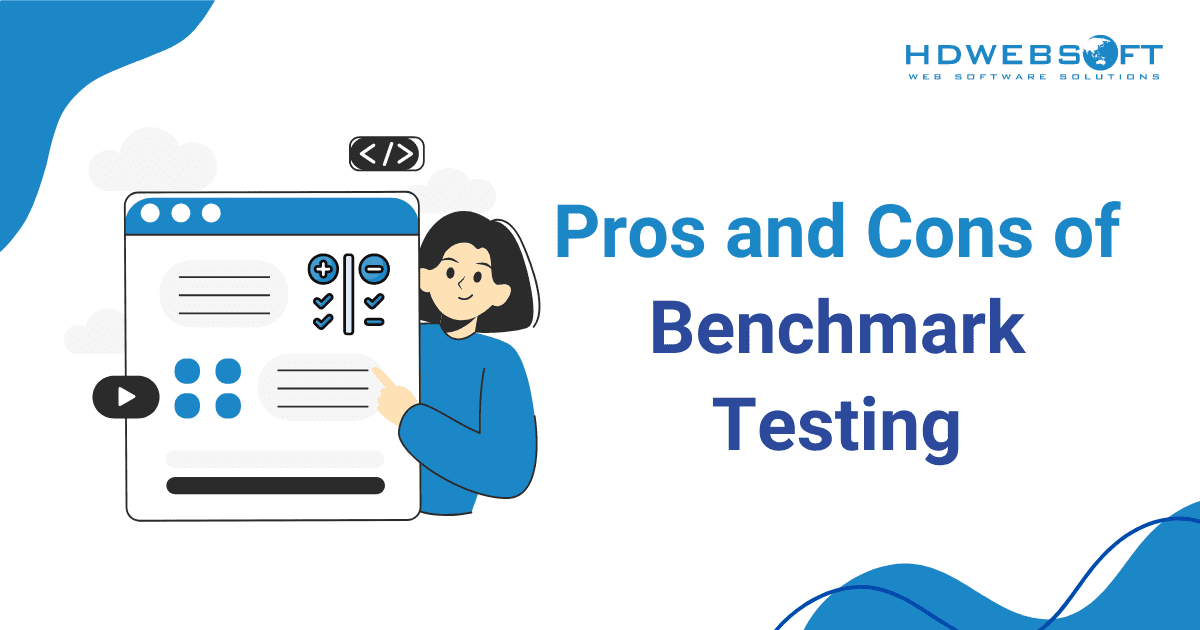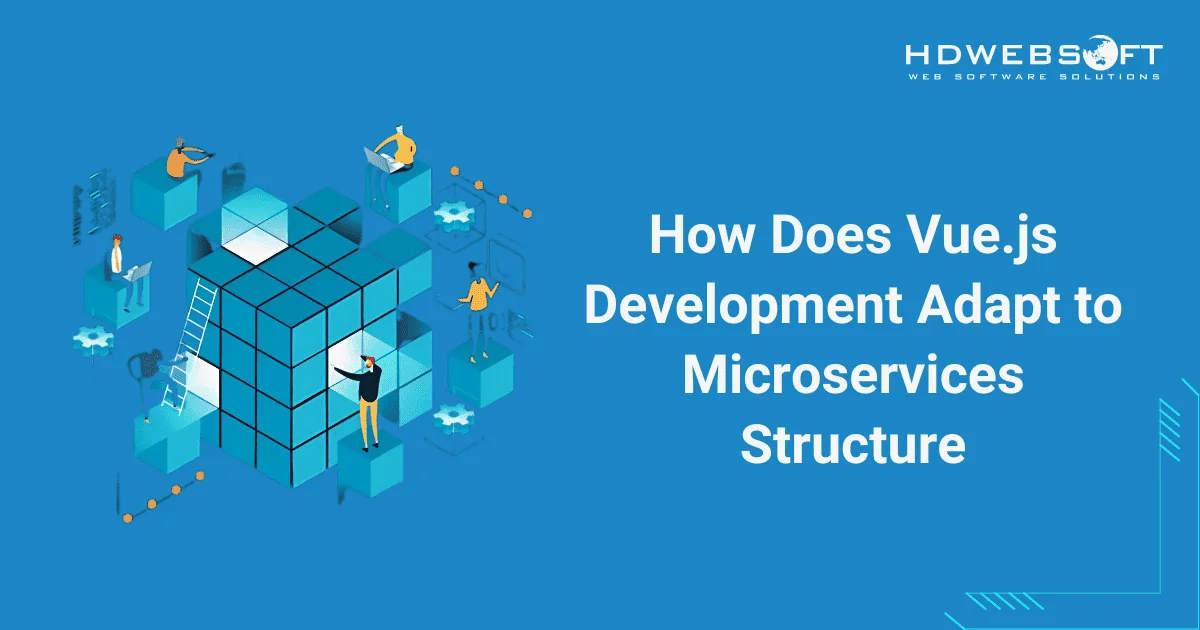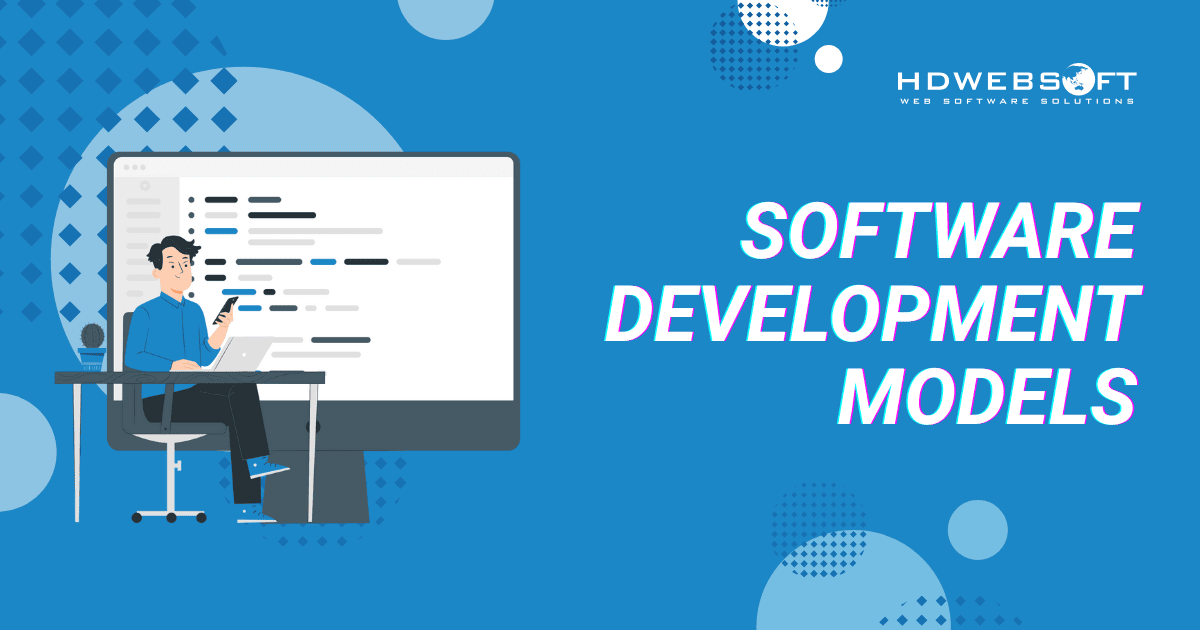
An Overview of Software Development Models
Software development models help guide teams through the challenging process of building software. The quality, timeline, budget, and success in meeting stakeholder expectations often hinge on the model selected.
Today, over 50 recognized software development life cycle (SDLC) models are in use. While none are flawless, each offers unique strengths and drawbacks depending on the project or team. Based on our over a decade of experience in software development, we’ve selected the 8 most popular models to explore their core principles and compare their key features.
A Look at Popular SDLC Models
Typically, software development models can be grouped by how they structure the workflow. Some follow a step-by-step sequence, while others use repeating cycles. These groupings also reflect the level of collaboration between the development team and the customer throughout the process.
Models positioned in the lower part of the chart follow a straightforward, linear structure. They’re typically easier to manage and implement, but are less flexible when changes arise. As you move upward, the SDLC models become more adaptable, allowing for adjustments in requirements as the project evolves.
On the horizontal axis, models on the left involve minimal customer interaction. In contrast, those on the right emphasize stronger collaboration, engaging customers more actively across multiple stages of development.
Overview of Software Development Models and Their Suitable Projects
Waterfall
The Waterfall model is one of the oldest and most straightforward software development models. It follows a linear path, where the process flows through distinct phases, including requirements, design, development, testing, deployment, and maintenance. Each phase is completed fully before moving on to the next, making the workflow structured and easy to follow.
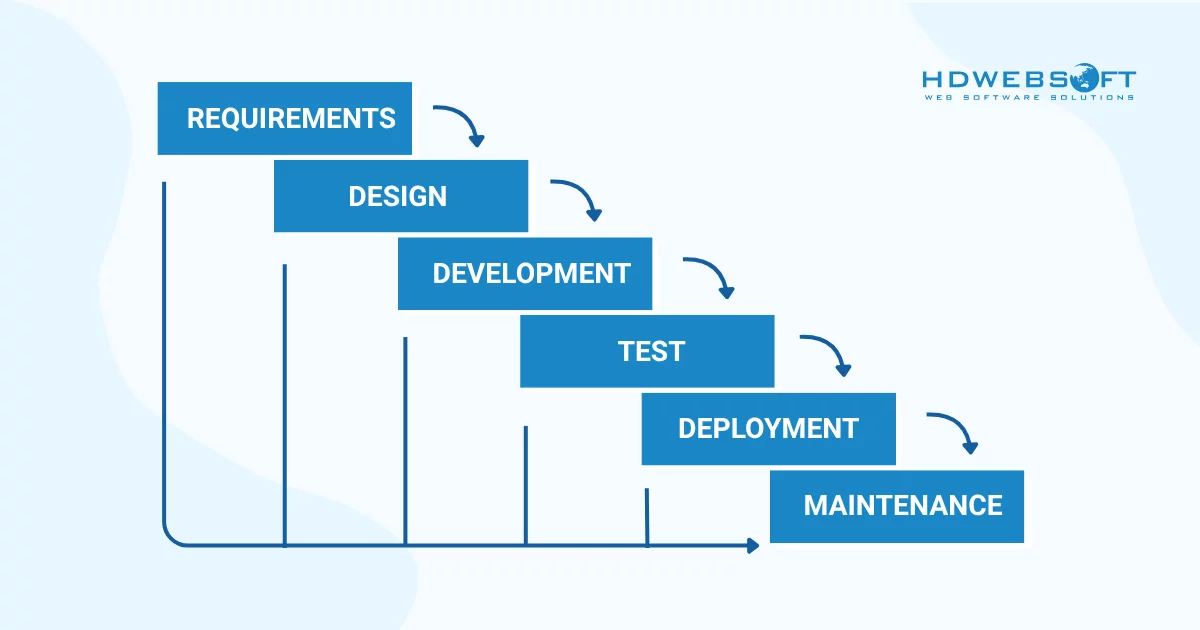
Thus, for example, software requirements cannot be re-evaluated once development has begun. There’s also no opportunity to view or test the software until the final stage is complete, which increases project risks and makes outcomes harder to predict. As a result, testing is often rushed, and fixing errors late in the process can be time-consuming and expensive.
Use cases
- Projects with clear, fixed requirements and low risk of scope changes.
- Short-term or low-complexity projects, including legacy system updates.
- Government, defense, or regulated contracts require strict documentation and adherence to compliance standards.
- Systems need formal approval at each phase before moving forward.
Also Worth Mentioning: An Unstructured Approach — The Big Bang Model.
V-Model
The V-model is a software development model that builds on the Waterfall model. Specifically, it focuses on verification and validation throughout the process. The steps form a V shape. On the left side, it covers specification and design, while on the right side, it covers testing phases. More importantly, each development step has a matching test phase. Consequently, this helps catch defects early and reduces the risk of costly fixes later.
However, the V-model is the most costly and rigid among traditional SDLC models. It requires strict planning and clear requirements from the start. Changes during development can be expensive and difficult to manage. Therefore, it’s less suitable for projects with evolving or unclear needs.
Implementation contexts
- Projects with well-defined and stable requirements.
- Safety-critical systems encompass telehealth, aerospace, and automotive industries.
- Software projects require strict regulatory compliance and thorough documentation.
- Systems where early and continuous testing is essential to ensure quality.
Incremental and Iterative model
Incremental model
The Incremental model is one of the software development models that breaks the process into multiple iterations. Specifically, it requires a modular, “Lego-style” design to support gradual growth and expansion. In each iteration, new software modules are added with little or no modification to the ones built earlier.
Additionally, the development process can move forward either sequentially or in parallel. In particular, parallel development can significantly speed up delivery. On the other hand, excessive repetition of sequential development cycles may result in longer timelines and higher project costs.
Iterative model
In Iterative development, the software evolves through repeated cycles, with changes introduced in each iteration. Since each iteration builds on the last, the overall software design stays consistent. This approach allows the product to grow gradually while maintaining structural integrity.
Because the software is delivered in parts, a complete specification isn’t required at the beginning. Instead, small changes to requirements can be made throughout the development process. However, major requirements, especially those related to system design, must be defined early. This is particularly important for Incremental development, where integration of new modules can become difficult if foundational requirements change later.
In short, both software development models encourage customer input. Although the Iterative model relies more on ongoing feedback, the Incremental model uses it to refine future deliveries.
Use Cases
- Projects with evolving or partially defined requirements that benefit from continuous customer feedback.
- Large systems can be broken into smaller, independent modules for faster and parallel development.
- Applications requiring early delivery of core features, with gradual enhancement over time.
- Long-term or complex projects require frequent testing and design refinement, which are needed through multiple iterations.
Spiral Model
The Spiral model emphasizes detailed risk assessment. Therefore, to fully leverage its advantages, it’s important to involve experts skilled in evaluating risks. Each Spiral iteration typically spans about six months and begins with four key activities. They are comprehensive planning, risk analysis, prototype development, and assessment of the previously completed work. It’s worth noting that multiple spiral cycles can significantly lengthen the overall project timeline.
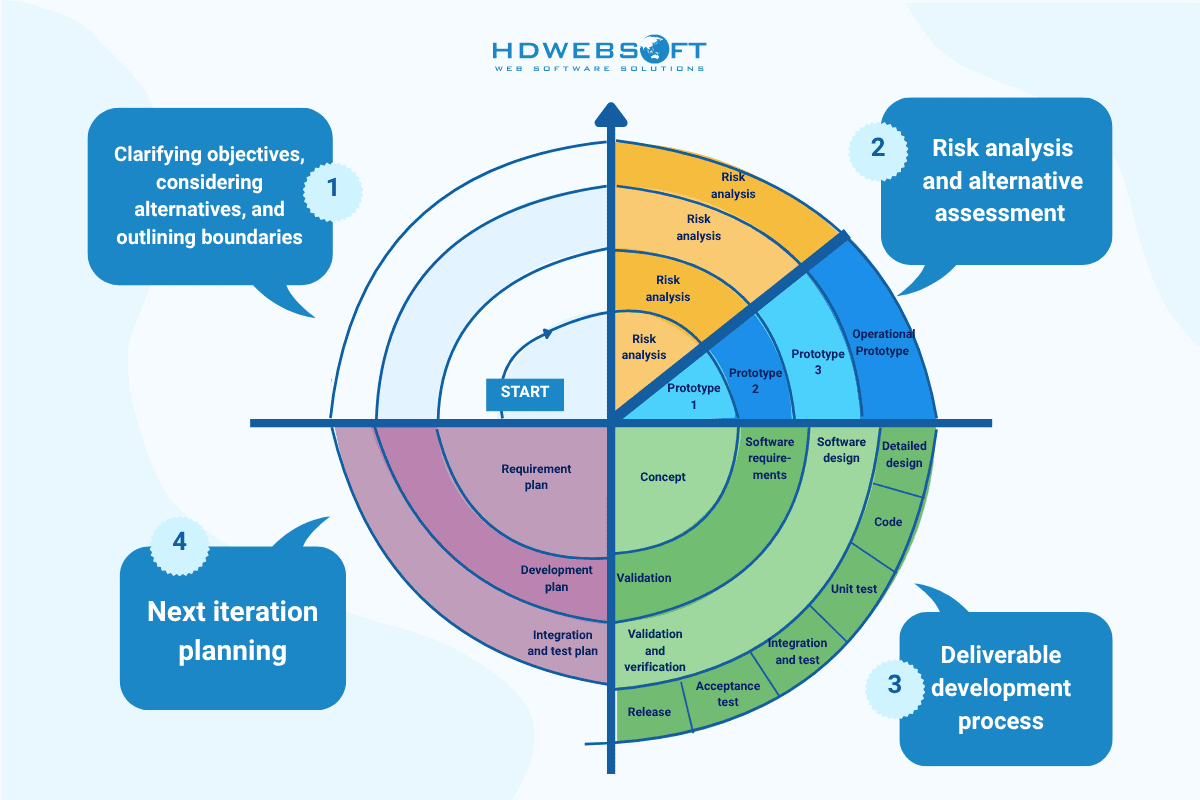
This and similar software development models also require customer participation, especially during the exploration and review phases of each cycle. However, once the development stage begins, changes from the customer are generally not allowed.
Implementation contexts
- Complex projects with high-risk factors require continuous risk assessment.
- Systems where requirements are not fully understood upfront and may evolve.
- Projects demanding early prototyping to validate concepts and reduce uncertainties.
- Software developments need frequent customer feedback during the planning and review phases.
The Rational Unified Process (RUP)
The Rational Unified Process (RUP) combines both linear and iterative approaches. It breaks down software development into four phases: inception, elaboration, construction, and transition.
Except for the inception phase, each phase typically includes multiple iterations. Throughout these phases, core activities like requirements gathering and design occur simultaneously but with varying levels of focus.
Additionally, RUP enables the creation of solutions that are both stable and flexible. That said, it is generally less fast and adaptable compared to pure Agile software development models. The level of customer involvement, amount of documentation, and length of iterations can be adjusted based on the specific needs of the project.
Practical cases
- Large-scale projects requiring a structured yet flexible development approach
- Projects needing a clear phase-wise progression combined with iterative refinement
- Organizations transitioning from traditional waterfall to more iterative methods
- Software development efforts with varying levels of customer involvement and evolving requirements
Agile Software Development Model Group
The rest of the SDLC models fall under the umbrella of Agile. Today, 71% of organizations use some form of Agile in their IT projects. These models emphasize iterative progress, strong team communication, and early feedback from customers.
Each Agile iteration typically lasts a few weeks and results in a working version of the software. Agile-based methods prioritize the quick delivery of usable features, focusing on testing over extensive documentation. This speeds up development but can slow down handover to support teams. Ultimately, this makes maintenance more challenging due to the limited system documentation.
What’s more, Agile software development models promote close collaboration within development teams and with clients. After every iteration, stakeholders assess progress and adjust priorities to align better with business goals and user expectations. Hence, return on investment is significantly improved.
Furthermore, frequent releases are a key trait of Agile methods. These models support ongoing improvements, quick fixes, and rapid feature updates. Still, because of minimal upfront planning and flexibility to change, accurately predicting costs, timelines, and staffing needs can be challenging.
Scrum
Scrum is one of the most widely adopted SDLC models within the Agile framework. It focuses on delivering working software in short, structured cycles known as sprints. These sprints typically last between 2-4 weeks, aiming to provide incremental value with each release.
Moreover, Scrum promotes transparency and encourages team accountability. It also supports continuous improvement through clearly defined roles and responsibilities. Additionally, it relies on structured events like daily stand-ups, sprint reviews, and retrospectives to maintain an organized and efficient process.
Among Agile software development models, Scrum stands out for its disciplined yet flexible approach. Each sprint begins with detailed planning and an evaluation of the previous sprint’s outcomes. Once the sprint scope is set, changes are not allowed until the next cycle begins. This time-boxed approach helps teams stay focused and committed to their goals while maintaining a steady pace of development.
Extreme Programming (XP)
With Extreme Programming (XP), a typical iteration lasts between 1-2 weeks. This model allows changes to be introduced even after an iteration has started. However, this is only possible if the team has not yet begun working on the affected software component. Nevertheless, this level of flexibility can make it much harder to consistently deliver high-quality software.
To address this challenge, XP enforces several strict development practices. These include pair programming, test-driven development, and test automation. Plus, it promotes continuous integration (CI), frequent small releases, and simple software design. It also requires developers to follow consistent coding standards throughout the project.
Kanban
Among software development models, Kanban stands out due to its lack of clearly defined iterations. If iterations are used at all, they are extremely short, often referred to as ‘daily sprints’. Instead of relying on fixed cycles, Kanban emphasizes visualizing the workflow. Accordingly, teams use a Kanban Board that clearly displays all project activities, their quantity, assigned team members, and current status. This increased transparency allows for better prioritization of urgent tasks.
Besides, unlike other SDLC models, Kanban does not have a separate planning stage. As a result, new change requests can be introduced at any time. Communication with the customer is continuous. They can review progress at any time, and meetings with the team may occur daily. Thanks to its flexible and visual nature, Kanban is often applied in software support and continuous improvement projects.
Further reading: Engagement Models in Software Development.
Conclusion
The landscape of software development models is diverse, with each model serving different types of projects and development needs. Understanding their structure, principles, and typical use cases provides valuable insight into how software evolves across industries. This overview highlights the most widely used models and the scenarios where they are most effective.













